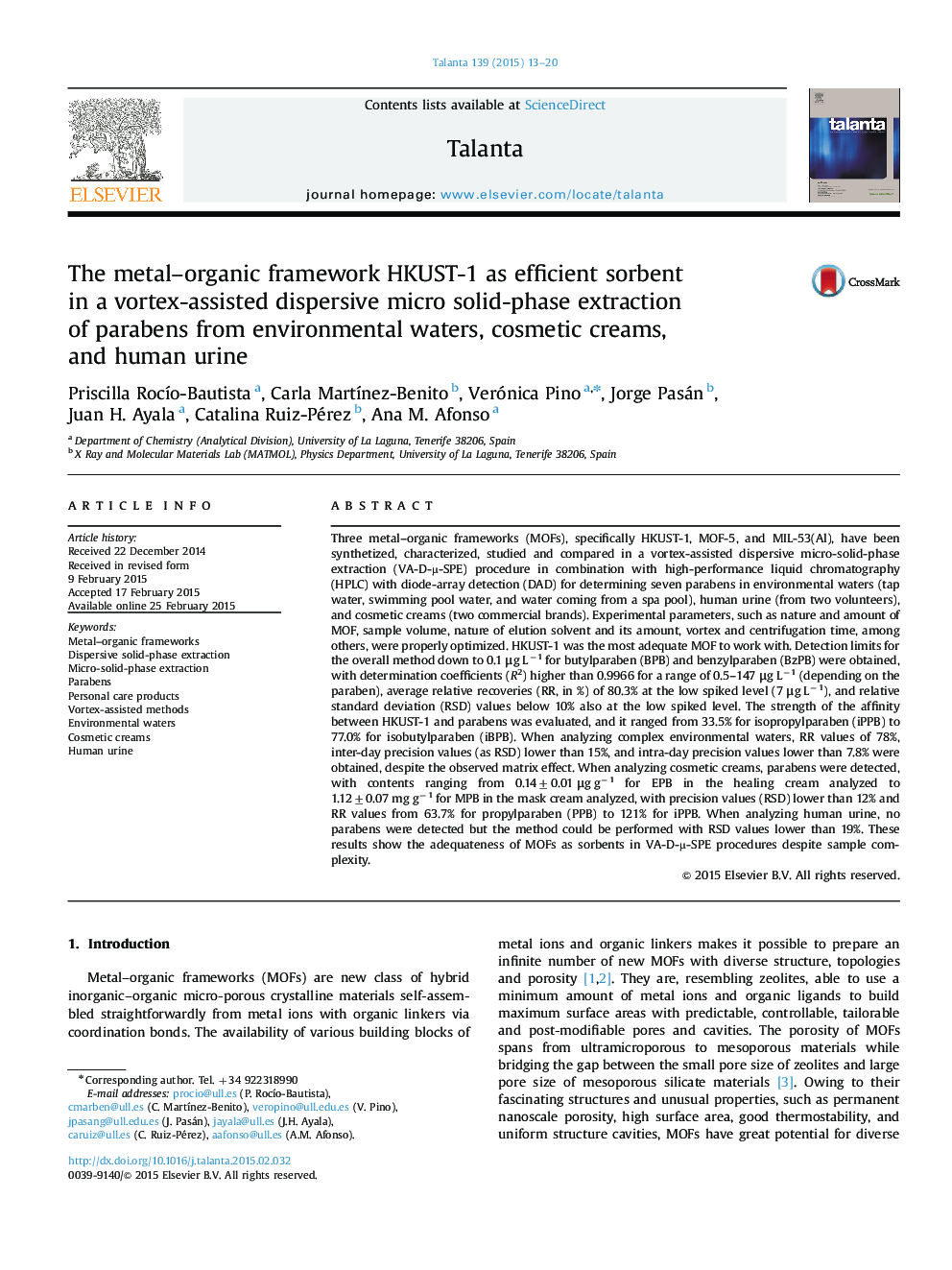| کد مقاله | کد نشریه | سال انتشار | مقاله انگلیسی | نسخه تمام متن |
|---|---|---|---|---|
| 1242231 | 1495796 | 2015 | 8 صفحه PDF | دانلود رایگان |

• Three MOFs, HKUST-1, MIL-53 and MOF-5, are applied for first time as sorbents for parabens.
• MOFs were used in a dispersive micro-solid-phase extraction approach assisted by vortex, with HPLC-DAD.
• HKUST-1 proved to be a suitable sorbent for parabens in waters, cosmetic creams and human urine.
• The VA-D-µ-SPE-HPLC-DAD using HKUST-1 was optimized and validated.
• Limits of detection down to 0.1 µg L−1 were obtained under optimum conditions only using ~20 mL of sample.
Three metal–organic frameworks (MOFs), specifically HKUST-1, MOF-5, and MIL-53(Al), have been synthetized, characterized, studied and compared in a vortex-assisted dispersive micro-solid-phase extraction (VA-D-µ-SPE) procedure in combination with high-performance liquid chromatography (HPLC) with diode-array detection (DAD) for determining seven parabens in environmental waters (tap water, swimming pool water, and water coming from a spa pool), human urine (from two volunteers), and cosmetic creams (two commercial brands). Experimental parameters, such as nature and amount of MOF, sample volume, nature of elution solvent and its amount, vortex and centrifugation time, among others, were properly optimized. HKUST-1 was the most adequate MOF to work with. Detection limits for the overall method down to 0.1 μg L−1 for butylparaben (BPB) and benzylparaben (BzPB) were obtained, with determination coefficients (R2) higher than 0.9966 for a range of 0.5–147 μg L−1 (depending on the paraben), average relative recoveries (RR, in %) of 80.3% at the low spiked level (7 μg L−1), and relative standard deviation (RSD) values below 10% also at the low spiked level. The strength of the affinity between HKUST-1 and parabens was evaluated, and it ranged from 33.5% for isopropylparaben (iPPB) to 77.0% for isobutylparaben (iBPB). When analyzing complex environmental waters, RR values of 78%, inter-day precision values (as RSD) lower than 15%, and intra-day precision values lower than 7.8% were obtained, despite the observed matrix effect. When analyzing cosmetic creams, parabens were detected, with contents ranging from 0.14±0.01 μg g−1 for EPB in the healing cream analyzed to 1.12±0.07 mg g−1 for MPB in the mask cream analyzed, with precision values (RSD) lower than 12% and RR values from 63.7% for propylparaben (PPB) to 121% for iPPB. When analyzing human urine, no parabens were detected but the method could be performed with RSD values lower than 19%. These results show the adequateness of MOFs as sorbents in VA-D-µ-SPE procedures despite sample complexity.
Figure optionsDownload as PowerPoint slide
Journal: Talanta - Volume 139, 1 July 2015, Pages 13–20